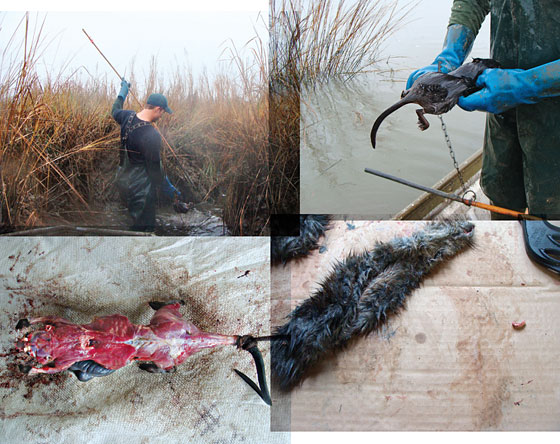
A south Jersey marsh in a December drizzle isn’t pleasant. It’s gray. And there’s a great deal of mud. But with a guide like John Zander—all strong shoulders and Boy Scout manners—the salty morning breeze has a measure of charm. Zander is steering an outboard motorboat across the creeks of the Cohansey River, raindrops beading on his backward baseball cap. As an island of trees emerges in the mist, Zander drives the skiff smack into a muddy bank, steps off the bow into shoulder-high reeds, and grabs one marked with a strip of pink plastic. The reed, in fact, is a stake marking one of 120 traps he set yesterday. With a firm yank, it’s out of the mud, a short chain swinging at the end. “And there he is,” says Zander. “He” is a furry, rubbery-tailed carcass squashed inside a square metal shoebox-size frame—a freshly caught wild native New Jersey muskrat.
Algonquin mythology credits muskrats for making the Earth out of mud from the primordial sea. The settlers who followed Henry Hudson into the Delaware Bay, Zander’s current hunting grounds, trapped and traded muskrat, and the animals are still found in healthy numbers there. Zander has his engineering degree and M.B.A., but, at 29, he’s decided to stick with the family fur trade, following his dad, Harry Zander, his Uncle Tommy, and his granddad before that. T. Zander & Sons has operated here, about 100 miles from Manhattan in New Jersey’s southwest corner, where it owns 1,300 marshy acres, since 1958. In the sixties and seventies, the Zanders sold mostly to Manhattan’s furriers. In the eighties, demand shifted to Europe. More recently, the bulk of their output has been sold to Chinese distributors. But that could change soon. With interest in fur rising in the West and labor costs in China increasing, Zander says the phone is once again ringing from European manufacturers looking for muskrats. Meanwhile, farmed-mink prices have reached upwards of $80 per skin—compared with about $8 for a similarly glossy brown muskrat—so domestic designers have begun to include muskrat, a.k.a. “the poor man’s mink,” in their collections. Between the creatures they trap themselves and skins brought in from other trappers, the Zanders expect to handle around a half-million muskrats this year. (They also deal in wild foxes, beavers, coyotes, and raccoons, but muskrats have always been the Zanders’ staple.)
T. Zander & Sons’ West Deptford headquarters is a low concrete building across a gravelly road from two grazing ponies. Just in from the marsh, Zander carries two crates of dead muskrats into a garagelike work space and plunks them down. He grabs one carcass and loops a length of rope around its tail. It hangs there like a rubber chicken covered in matted fur until Zander begins to score it with a paring knife above the back feet, then pulls down the skin as if removing a sweater, stopping at the face to make a cut above each beady eyeball. “Sometimes one just pops up and hits you.”
The detached pelt looks like a deflated furry football with a cute nose and whiskers. Zander turns it inside out, stretches it over a wooden plank, and begins to scrape the skin with a blade. If the fat isn’t removed, the skin will rot and the fur will fall off. Next he pulls the skin over a frame to dry. What covered a muskrat corpse five minutes ago now resembles a small, bloody ironing board. (The animal’s meat goes into the refrigerator for adventuresome area epicures.) After drying for three days, the skins are graded and sorted by size and quality, then wrapped in cardboard, squeezed into bales in lots of 1,500, and shipped out.
Zander likens wild-caught muskrat pelts to diver scallops. “Instead of a big machine, it’s an actual person grabbing them.” But while foodies pay a premium for wild seafood and game, fur buyers often place higher prices on pelts from farm-raised animals, which are bred to be big, plush, and predictable. These wild animals’ fur, by comparison, can be small, scrappy, and scarred.
Zander says he works as humanely as possible. He uses body-grip traps because they snap the animals’ necks, killing them instantly, whereas cage traps, which drown the animals, prolong their deaths. And because a muskrat’s reproduction rate can rival that of a rabbit, Zander believes that trapping the animals helps keep the marsh healthy. Still, he understands that no matter how conscientious he is, there are people who find his career morally indefensible. Protesters have gathered outside the Zanders’ workshop, and once, when John was a boy trapping near a road, a driver yelled that he’d like to catch him in a trap.
A single wall separates the drying skins from T. Zander & Sons Country Fur Salon, a shop where the Zanders’ secretary, Shelley, doubles as the sales clerk, and business these days is brisk. There, among the jackets and trapper hats, is a soft, sporty zip-up vest with a $695 price tag. With natural-colored fur varying from sandy brown to deep brunette, the vest looks not unlike one available at Barneys for $1,825, made in China from Spanish raccoons. The Zanders’ version, of course, is 100 percent local muskrat.